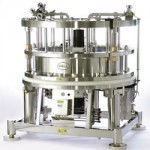 As upstream processing becomes more optimized, it increases the amount of impurity and contaminants to be removed from large volumes of feedstock. With this added pressure on downstream processing, there is a pressing need for more efficient chromatography operations.
As upstream processing becomes more optimized, it increases the amount of impurity and contaminants to be removed from large volumes of feedstock. With this added pressure on downstream processing, there is a pressing need for more efficient chromatography operations.
In this paper, the authors describe how they characterized differentiated selectivity of Q and S HyperCel ion-exchange sorbents. They evaluated the dynamic binding capacity in various pH, conductivity, and residence time conditions; carried out a separation of a model mixture to further characterize the sorbents’ specific selectivity; and report on a real case application in which one was used in a capture step for purification of a recombinant protein from an E. coli lysate.
